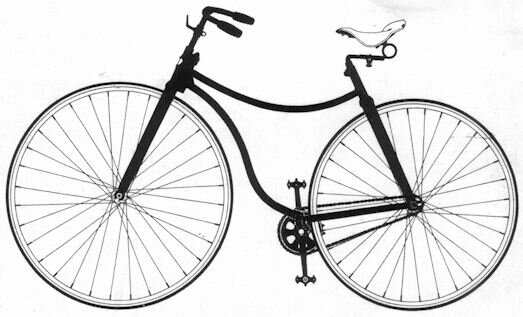
Rover - How it all began. 
By Kevin Phillips
The history of the Rover Company goes back to 1881 when the Coventry Sewing Machine Company was founded. From sewing machines, they graduated to manufacturing bicycles in 1869. The first Rover machine was a tricycle which appeared in 1884 and a year later the new safety bicycle appeared and the company then became known as JK Starley & Co Ltd.
John Starley's safety bicycle was the prototype of the modern pedal cycle and was developed to overcome the balancing problems of the common penny-farthing cycle. Tricycles had been easier to control than the high and ungainly "ordinaries as the penny farthings had come to be known, but were not as maneuverable and were much more expensive.
John Starley's safety bicycle featured a rear wheel that was driven by a chain and gearing which would reduce the effort required by the rider and would enable the front wheel diameter to be dramatically reduced.
Once his safety bicycle had proved a success, Starley began experimenting with an electrically driven battery-powered tricycle. The batteries were placed in a wicker basket above and behind the rear axle with the electric motor fitted underneath. Unfortunately, it was not a success as the performance and range was pitiful and once the batteries had gone flat, the dead weight of the machine would have taxed even the strongest of riders.
Starley's safety bicycles caught on rapidly and the business went from strength to strength with rapidly rising sales which made John Starley a wealthy man.

In June 1896, Starley formed the Rover Cycle Co Ltd which operated from the New Meteor Works. In its first year of operation, the new company built 11000 cycles and returned a profit of 21,945 pounds. At about this time, an entrepreneur by the name of Harry Lawson had arrived in Coventry and taken over a disused cotton mill in order to manufacture his license-built Daintier motor car. Lawson was a man who was going places and, expanding by acquisition, tried to induce Starley to join forces with him. Starley would have no part of it, but it did get him thinking about engines and their possibilities.
Starley imported several Peugeot motorcycles from France in 1899 for observation and experimental work. This was a natural progression as by the end of the nineteenth century the motor car phenomenon was taking the world by storm and Britain already had motor cars being built by Daim]er, Wolseley, Lanchester and Riley.
Rover's first project was to motorise a Rover pedal cycle, something that Triumph was already working on.
John Starley died tragically early in October 1901 aged 46, while still the undisputed leader of Coventry's bicycle industry, his business now producing 15,000 machines a year.
Harry Smith took over as Managing Director and made the decision to go motorised in 1902. The first public appearance of the 2% HP Rover motorcycle was made on 24th November 1902.
By now Britain's fledgling motorcar industry was starting to show signs of stability and Daimler was turning out good cars and making good money. On 16th December 1903 the Rover directors decided to start development of a light car. It would be designed by Edmund Lewis who had been acquired from Daimler who were the acknowledged motorcar experts. Rover's decision had been made just in time as by now Daimler and Riley in Coventry had been joined by Annstrong-Siddeley, Humber, Lea-Francis, Singer and Standard.

